Discover Florida Nature
It's time to explore the natural Florida


|
|
|
|
|
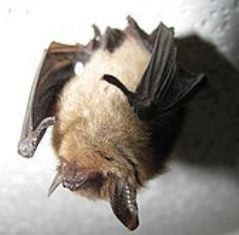 Northern
Long-eared Myotis- Northern long-eared bats are small bats,
typically 5-10 g and 84 mm in total length. The fur is dull brown on the
dorsum and yellowish on the venter. Compared to other bat species, these
bats have long ears with a relatively long tragus in each ear. This
species is found primarily in coniferous forest from Newfoundland to the
Yukon, and in the southeastern United States through to Florida.
Although the northern long-eared myotis is common and widespread, much
remains to be learned about its roosting habits, reproduction, and
longevity. This bat is known to hibernate in caves and mines and to
roost under tree bark. It is one of the gleaners, plucking insects from
the surfaces of leaves, branches, and the ground rather than taking them
from the air in flight. Northern long-eared myotis hang from a perch to
eat, which lets them take larger insects than they could if they ate on
the wing. Northern
Long-eared Myotis- Northern long-eared bats are small bats,
typically 5-10 g and 84 mm in total length. The fur is dull brown on the
dorsum and yellowish on the venter. Compared to other bat species, these
bats have long ears with a relatively long tragus in each ear. This
species is found primarily in coniferous forest from Newfoundland to the
Yukon, and in the southeastern United States through to Florida.
Although the northern long-eared myotis is common and widespread, much
remains to be learned about its roosting habits, reproduction, and
longevity. This bat is known to hibernate in caves and mines and to
roost under tree bark. It is one of the gleaners, plucking insects from
the surfaces of leaves, branches, and the ground rather than taking them
from the air in flight. Northern long-eared myotis hang from a perch to
eat, which lets them take larger insects than they could if they ate on
the wing.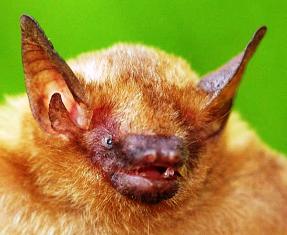 Northern
Yellow Bat- Found throughout the state, the most common species
of solitary bat found in southern Florida is the northern yellow bat.
A large, yellowish-brown bat with short ears and long, silky fur;
These bats are larger than the red and Seminole bats. Clumps of Spanish
moss make good daytime roosting places for northern yellow bats. Small
groups of males or slightly larger groups of females are often found
roosting together in forested areas near a permanent source of water.
They are seldom found roosting in houses or other manmade structures.
They feed over open spaces: they are seen over golf courses, beaches,
and along the edges of ponds, hunting for
mosquitoes, flies, and other insect prey. Barn
owls are known to prey on them. Unlike most other
Lasiurus bats, they have only two nipples, and if a female gives
birth to more than two offspring, usually only two survive. Young are
born in May or June and are flying by June or July. Northern
Yellow Bat- Found throughout the state, the most common species
of solitary bat found in southern Florida is the northern yellow bat.
A large, yellowish-brown bat with short ears and long, silky fur;
These bats are larger than the red and Seminole bats. Clumps of Spanish
moss make good daytime roosting places for northern yellow bats. Small
groups of males or slightly larger groups of females are often found
roosting together in forested areas near a permanent source of water.
They are seldom found roosting in houses or other manmade structures.
They feed over open spaces: they are seen over golf courses, beaches,
and along the edges of ponds, hunting for
mosquitoes, flies, and other insect prey. Barn
owls are known to prey on them. Unlike most other
Lasiurus bats, they have only two nipples, and if a female gives
birth to more than two offspring, usually only two survive. Young are
born in May or June and are flying by June or July.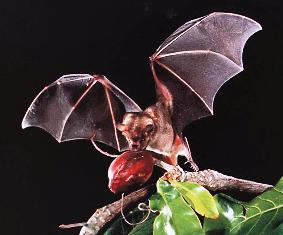 Rafinesque's
Big-Eared Bat- Rafinesque's big-eared bat inhabits forests and
streamside areas throughout the southeastern United States, including
Florida. The most noticeable feature of this bat is its ears, which are
more than an inch long. Rafinesque's big-eared bats are brown, with
white-tipped fur on their belly. Their wings and interfemoral membrane
are naked. This bat's large ears extend to middle of back when laid
down. These agile flyers may be less frequently seen than some other
bats because they leave their roosts only when it is completely dark,
forage for insects in the dark, and return to their roosts before
sunrise. Curiously, they prefer roosting in locations that have some
amount of light. Their range overlaps that of several other
forest-dwelling bats, such as the
eastern pipistrelle, the big brown bat, and some
members of the genus Myotis. The Rafinesque's big-eared bat
inhabits forested regions of
pine flatwoods
and
hardwood hammocks,
roosting in hollow trees, crevices behind bark, buildings and other
man-made structures, and under dry leaves. These bats are gleaners and
can sometimes be seen hovering to pick off insects from leaves. They are
slower flyers with excellent maneuverability that allows them to fly
close to vegetation. Rafinesque's big-eared bats may live as long as 10
years. Rafinesque's
Big-Eared Bat- Rafinesque's big-eared bat inhabits forests and
streamside areas throughout the southeastern United States, including
Florida. The most noticeable feature of this bat is its ears, which are
more than an inch long. Rafinesque's big-eared bats are brown, with
white-tipped fur on their belly. Their wings and interfemoral membrane
are naked. This bat's large ears extend to middle of back when laid
down. These agile flyers may be less frequently seen than some other
bats because they leave their roosts only when it is completely dark,
forage for insects in the dark, and return to their roosts before
sunrise. Curiously, they prefer roosting in locations that have some
amount of light. Their range overlaps that of several other
forest-dwelling bats, such as the
eastern pipistrelle, the big brown bat, and some
members of the genus Myotis. The Rafinesque's big-eared bat
inhabits forested regions of
pine flatwoods
and
hardwood hammocks,
roosting in hollow trees, crevices behind bark, buildings and other
man-made structures, and under dry leaves. These bats are gleaners and
can sometimes be seen hovering to pick off insects from leaves. They are
slower flyers with excellent maneuverability that allows them to fly
close to vegetation. Rafinesque's big-eared bats may live as long as 10
years.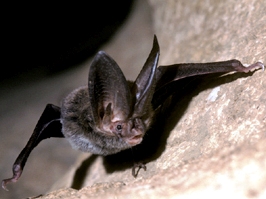 Little
Brown Bat-The little brown bat is a small mammal with a body
length of 3 - 31/2 inches and weighing approximately 1/8 to 1/2 an
ounce. The wingspan of little brown bats range from 6 - 8 inches. As
their name suggests little brown bats are glossy brown above with a
light buff color below. These bats can live 20 to 30 years. In summer
the little brown bat inhabits trees, bat houses, and buildings, usually
choosing a hot attic, where nursery colonies of hundreds and even
thousands form. Less frequently colonies form beneath tar paper, siding,
shingles, or other similar sheltered spots,. In the west colonies have
been found beneath bridges and in caves. Single males have been found in
attics, behind shutters under bark, in rock crevices, behind siding and
under shingles. Groups of males occasionally occur in caves. Little
Brown Bat-The little brown bat is a small mammal with a body
length of 3 - 31/2 inches and weighing approximately 1/8 to 1/2 an
ounce. The wingspan of little brown bats range from 6 - 8 inches. As
their name suggests little brown bats are glossy brown above with a
light buff color below. These bats can live 20 to 30 years. In summer
the little brown bat inhabits trees, bat houses, and buildings, usually
choosing a hot attic, where nursery colonies of hundreds and even
thousands form. Less frequently colonies form beneath tar paper, siding,
shingles, or other similar sheltered spots,. In the west colonies have
been found beneath bridges and in caves. Single males have been found in
attics, behind shutters under bark, in rock crevices, behind siding and
under shingles. Groups of males occasionally occur in caves. 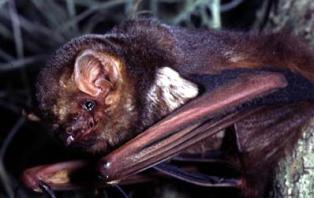 Seminole
Bat- This bat is is a medium-sized bat with deep mahogany fur
which is frosted at the tips, giving the bat a distinct reddish-maroon
hue, unlike the reddish orange of eastern red bats. The Seminole bat has
a furred tail membrane, well furred to the tip of its tail. Its fur
extends along the underarms to the wrists, ending with distinctive white
patches on the wrists and shoulders. The Seminole bat has a forearm
length of 35-45 mm and weighs 8-15 g. It can best be distinguished from
the red bat by its mahogany color. Hoary bats are much larger (forearm
50-57 mm) and yellow bats lack white wrist and shoulder markings. Unlike
the eastern red bat, the Seminole doesn't vary in color between the
sexes. Seminole bats are found in lowland, semi-forested and forested
areas. Seminole bats are greatly associated with the distribution of
tree-hanging Spanish moss, which they use as roosts, especially in
longleaf pines and oaks that border a clearing. Seminole bats emerge
early to forage, often concentrating above the tree crowns. Seminole
Bat- This bat is is a medium-sized bat with deep mahogany fur
which is frosted at the tips, giving the bat a distinct reddish-maroon
hue, unlike the reddish orange of eastern red bats. The Seminole bat has
a furred tail membrane, well furred to the tip of its tail. Its fur
extends along the underarms to the wrists, ending with distinctive white
patches on the wrists and shoulders. The Seminole bat has a forearm
length of 35-45 mm and weighs 8-15 g. It can best be distinguished from
the red bat by its mahogany color. Hoary bats are much larger (forearm
50-57 mm) and yellow bats lack white wrist and shoulder markings. Unlike
the eastern red bat, the Seminole doesn't vary in color between the
sexes. Seminole bats are found in lowland, semi-forested and forested
areas. Seminole bats are greatly associated with the distribution of
tree-hanging Spanish moss, which they use as roosts, especially in
longleaf pines and oaks that border a clearing. Seminole bats emerge
early to forage, often concentrating above the tree crowns.
|
|
|
Advertise | Privacy Statement | Contact | Alaska Nature | Michael Arnold Art| Dog Encyclopedia | Dog Encyclopedia| |
|